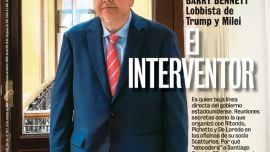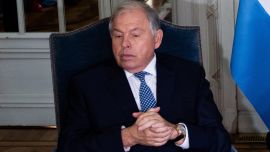Even before her brother became Argentina’s president, Karina Milei had already understood that one of her main tasks was to plant the party in all 24 electoral districts. And that she has done – in this Sunday’s election, La Libertad Avanza is the only political force in this election deploying its brand nationwide.
In contrast, infighting and different local realities on the ground have led to an electoral dispersion of Argentina’s main opposition Peronist front, without even managing to unify lists in some provinces. This fragmentation is not just a problem of assembly – it worries Fuerza Patria, which knows that on election night it could be at a disadvantage in the vote count.
The colour purple, the eagle and the name of La Libertad Avanza will be on each of the single paper ballots of the 23 provinces and Buenos Aires City. The Milei government was inflexible when it came time to discuss electoral alliances – anybody wanting to join would have to do so under the brand commanded by “El Jefe.” Karina thus managed to twist arms which seemed impossible – like PRO in the City of Buenos Aires and Buenos Aires Province – while obliging governors like Leandro Zdero, Rogelio Frigerio and Alfredo Cornejo to paint themselves purple. The latter at least managed to have the label in his province registered as La Libertad Avanza + Cambia Mendoza.
On the other side, there are cases which should not be debatable. Frente de la Victoria in Formosa are votes which should belong in the same space, just like Tucumán Primero, Unidos Podemos de Chubut, Defendamos La Pampa, Federales defendamos La Rioja, Fuerza Patria Peronista de Santiago del Estero, Fuerza Santacruceña, Fuerza Pueblo en San Luis, Fuerza San Juan, Fuerza Justicialista Mendoza and Fuerza Entre Ríos.
But there is a more worrying statistic for the opposition when it comes to showing results on election night. In various provinces (even in some where Fuerza Patria is running), Peronism is divided and that is where the discussion as to where to place votes becomes more problematic.
In Córdoba, Pablo Carro will head the official list but Defendamos Córdoba, led by Natalia de la Sota, is also competing. In Entre Ríos, Fuerza Patria is running with Guillermo Michel (Sergio Massa’s right-hand man) and Adán Bahl but also a second Kirchnerite list under Carolina Gaillard. In Salta, Peronism is also divided – Juan Manuel Urtubey and Emiliano Estrada head the Fuerza Patria list, against which Senator Sergio “Oso” Leavy will compete with the Partido de la Victoria.
In Jujuy, Fuerza Patria is led by Leila Chaher but will face Peronist competition with Frente Primero Jujuy Avanza. In Chubut, Peronism will deploy Unidos Podemos, led by Juan Pablo Luque, and La Fuerza del Trabajo Chubutense under Alfredo Beliz.
In San Luis, the former four-term governor Alberto Rodríguez Saá is pushing his own list in competition against Fuerza Pueblo, the local brand of Fuerza Patria headed by Daniel González Espíndola. More infighting in Misiones, where La Cámpora deputy Cristina Benítez heads Fuerza Patria, against which Ramón Puerta competes with his Activar list.
In Tierra del Fuego there will be three Peronist lists: Fuerza Patria, Frente Grande y Defendamos Tierra del Fuego.
Buenos Aires Province has it clearer. Lists like Unión Federal carrying Fernando Gray or Partido Nuevo Buenos Aires under Santiago Cúneo cannot enter into the count.
Peronism aims for the vote totals to take into account Fuerza Patria, provincial Peronists and allies like the Frente Cívico por Santiago de Estero responding to outgoing governor Gerardo Zamora. They are only inclined to chop off the total the two Buenos Aires Province lists and those of González Espíndola in San Luis and Beliz in Chubut.
The rest? Inside the fold. The problem is that the national government entrusted with conveying the election night information has already served notice that it will leave “out” the “blue” unofficial lists.




















Comments